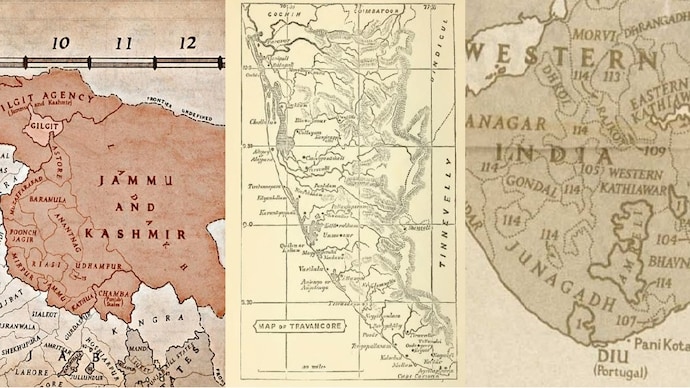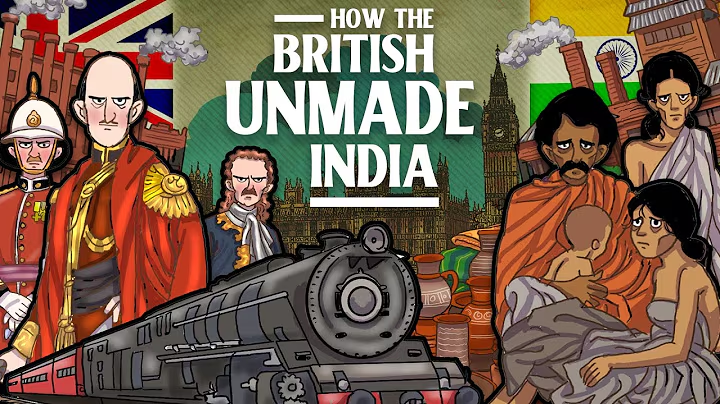

15:54
.......................................................................................................................................................
From Jammu & Kashmir to Jodhpur, 6 princely states which refused to join India
[BECAUSE COLONIAL BRITISH RULER WANTED TO DIVIDE INDIA INTO MANY PARTS]
]After India's independence, several princely states, from Jammu & Kashmir to Jodhpur, hesitated or outright refused to join the Indian Union. These decisions stirred political tensions and posed a major challenge to Sardar Patel and the newly formed Indian government.

The division of India and the creation of Pakistan posed a tough choice for princely states
New Delhi,UPDATED: Nov 8, 2024 19:43 IST
"If a basket of fruit is to be offered, then it must be with big fruits like Hyderabad and Kashmir." -- That's how Sardar Vallabhbhai Patel denoted the case of princely states during the time of India's independence.
When Patel got the opportunity to make the Indian princely states part of India, he faced the toughest challenge: integrating 565 princely states into India. Basting together hundreds of territorial knobs into a distinct whole was an aspiration that would make or break Independent India.
The division of India and the creation of Pakistan posed a tough choice for princely states. Merging their lands was another uphill struggle.
For centuries, these princely states had been tactfully manipulated by European powers. The British had allowed some states, like Jammu and Kashmir, to remain largely autonomous, while Hyderabad was ruled by the Razakars despite the British presence. Many of the small Rajputana states (now Rajasthan) lived under semi-authoritarian rule.
The British often called these Indian 'Maharajas' their best allies and a strong pillar of the British Empire in India.
Historian Barbara Ramusack notes, “British colonial officials had claimed them as faithful military allies, denounced them as autocrats, praised them as natural leaders of their subjects, chided them as profligate playboys, and taken advantage of their lavish hospitality.”
After the departure of the British, the princely states were asked to join either the newly created Pakistan or the centuries-old nation of India, which had a diverse cultural norm.
During the 1931 Round Table Conference in London and later at the Haripura session in 1938, Congress made it evident that the states were integral parts of India and could not be separated.

In response, new government departments were created to integrate all the remaining states into India’s union. Sardar Vallabhbhai Patel was entrusted with this monumental task, and VP Menon was appointed as the secretary to oversee the process.
However, the last Viceroy of India, Lord Mountbatten, also played a significant role in politically supporting this cause.
Bikaner and Baroda were among the first to join the Indian union, followed by other states of Rajputana. Despite these efforts, some states still refused to join.
But why did these states resist joining India? Here's more about the states that refused to join and the political turmoil with which India was dealing on the eve of independence:
1. THE CURIOUS CASE OF JAMMU & KASHMIR

Princely states, including Jammu and Kashmir, were given the choice to join either country or remain independent. Maharaja Hari Singh, the Dogra ruler of Jammu and Kashmir, opted for neutrality, hoping to preserve the state’s sovereignty in a delicate geopolitical situation.
However, this neutrality was short-lived. In October 1947, militias from Pakistan who actually were the soldiers of the Pakistani army invaded Jammu and Kashmir, prompting a crisis. Facing the threat of losing his kingdom, Maharaja Hari Singh reached out to India for military support.
This led to the signing of the Instrument of Accession on October 26, 1947, whereby Jammu and Kashmir officially became a part of India.
2. STATE OF JODHPUR IN THE DESERT

Maharaja Hanwant Singh, the young ruler of Jodhpur, initially leaned toward India. The princely state of Jodhpur, despite having a Hindu majority and a Hindu ruler, briefly entertained the idea of joining Pakistan before India’s independence in 1947.
However, given Jodhpur’s geographic proximity to Pakistan, as it sits at a fair distance of 170 miles, he reconsidered his options, influenced by offers from Pakistan’s founder, Muhammad Ali Jinnah.
Jinnah tempted the Maharaja with promises of unrestricted port access in Karachi and military and agricultural aid for the state, which seemed appealing for Jodhpur’s development.
On the other hand, Patel, India's then-deputy Prime Minister, emphasised the strategic and practical challenges of Jodhpur aligning with a Muslim-majority country and presented a range of benefits for joining India.
These discussions eventually persuaded Maharaja Hanwant Singh to commit to India.
3. COASTAL STATE OF TRAVANCORE

In 1947, as India prepared for independence, the princely state of Travancore, under Maharaja Chithira Thirunal and his sharp-minded Diwan, Sir CP Ramaswami Iyer, considered charting its own path.
With its valuable monazite deposits (key for nuclear material) and a strategic location on the Arabian Sea, Travancore saw itself as self-sufficient enough to avoid joining either India or Pakistan. Sir CP Iyer even hinted at negotiating foreign treaties independently, eyeing a path of complete autonomy.
Tensions rose when an assassination attempt was made on Sir CP, which rattled Travancore's leaders. Realising the delicate political landscape, and under mounting pressure, Travancore ultimately signed the Instrument of Accession, joining India.
4. JUNAGADH IN GUJARAT

Junagadh's story during India's independence is an interesting one. When British India was being divided in 1947, the state of Junagadh, which had a predominantly Hindu population, chose to join Pakistan under its Muslim ruler, Nawab Mahabat Khan.
This decision was unusual because Junagadh was geographically located within India, separated from Pakistan by a considerable distance.
India, concerned about this decision, argued that Junagadh's choice didn’t represent the wishes of its people. India imposed a blockade to put pressure on the state, and the Nawab soon fled to Pakistan. Later, India conducted a public vote, or plebiscite, in Junagadh, where the majority voted to join India.
As a result, Junagadh was officially integrated into India in early 1948.
5. HYDERABAD, THAT COULD BECOME 'A CANCER IN NATION'S BELLY'

Hyderabad was a princely state under the rule of the Nizam, Mir Osman Ali Khan, and it initially chose to remain independent after the partition of India in 1947.
Despite its large Hindu population, the Nizam, a Muslim ruler, hoped to keep the state separate from both India and Pakistan. Tensions rose as the Nizam refused to sign the Instrument of Accession, which would have officially integrated the state into India.
India, seeing the potential for instability in the region, took action. After failed talks, India launched 'Operation Polo' in September 1948, a military operation that swiftly ended the Nizam's resistance.
Hyderabad was then formally annexed into the Indian Union, ending its efforts to remain independent. This event was a crucial part of India's efforts to consolidate its territories after independence.
6. BHOPAL, THE STATE LED BY A WOMAN

Bhopal, a princely state ruled by the Nawab of Bhopal, was unique in that it was led by a woman, Nawab Sultan Jahan Begum, for much of the early 20th century.
After India's independence in 1947, Bhopal's ruler, Nawab Hamidullah Khan, initially hesitated to join the Indian Union, partly due to his fears of losing sovereignty.
Despite this, the Nawab was eventually persuaded to accede to India after consultations with the Indian government.
In 1949, Bhopal formally joined India, and its status as a separate state came to an end. However, the state's integration was relatively smooth compared to others, thanks to the diplomatic efforts and strategic leadership provided by both the Nawab and Indian leaders.
- Ends
History of British kidnap/ransoms in India 1800
Should the last Sikh maharajah be returned to India? - BBC News
3 incidents of kidnap by British
[1]kidnapping of 5 year old,child Maharaja by British
Dalip Singh was the youngest son of Maharaja Ranjit Singh.
He was born of Maharani Jindan on September 6, 1837.
At the age of five years he was proclaimed Maharaja of Punjab. According to the treaty of Lahore of March 1846 the British Government was responsible[means abduction] for the administration of the state and the protection of the Maharaja.
The British unjustly deposed the child Maharaja. On March 29 1849 at the age of twelve the young Dalip singh was made to sign over the the sovereignty of the Punjab and relinquish all claims to the property of his kingdom, including the Kohinoor diamond. The Maharaja stepped down from his fathers throne, never to sit on it again
Duleep Singh - Wikipedia, the free encyclopedia
https://en.wikipedia.org/wiki/Duleep_Singh
[2]

Tipu Sultan - Wikipedia, the free encyclopedia
en.wikipedia.org
Louis XVI receives the ambassadors of Tipu Sultan in 1788. Tipu Sultan is known to have sent many diplomatic missions to France, the Ottoman Empire,

.
 Kidnapping for ransom - Tipu Sultan's sons are taken by British
Kidnapping for ransom - Tipu Sultan's sons are taken by British[3]revolt against British in southern state of travancore(now part of kerala
Travancore Rebellion - Wikipedia, the free encyclopedia
https://en.wikipedia.org/wiki/Travancore_Rebellion
informer ,from south
www.maphill.com
By the time of King Marthanda Varma, the southern half of the kingdom had .... were successful and on 18 December 1808 they stormed the Resident's house in ... Maharajah Chithira Thirunal was the only King of Travancore not to have ..
Travancore - Wikipedia, the free encyclopedia
https://en.wikipedia.org/wiki/Travancore
The raja never expected British knew the secret mountain route from south
Travancore royal family - Wikipedia, the free encyclopedia
https://en.wikipedia.org/wiki/Travancore_royal_family
THE RAJA WAS TAKEN AS VIRTUAL HOSTAGE
THE RANSOM TO FREE THE KING ;WAS FOR HIM TO HELP IN CAPTURE VELUTHAMPY
Velu Thampi Dalawa - Wikipedia, the free encyclopedia
https://en.wikipedia.org/wiki/Velu_Thampi_Dalawa
)
Freedom Struggle in Kerala
www.indianetzone.com270 × 300Search by image
Even backward groups revolted when the oppression of the British became extreme in this southern state. In 1812, the Kurichiya Tribe and Kurumba Tribe of ...
 The Veluthampi Revolt 1807-1809
The Veluthampi Revolt 1807-1809Balarama varma as an ineffective boy king, started his reign in 1798, and was fully under the control of one
List of Maharajahs of Travancore
Dutch commander De Lannoy surrenders to King Anizham Thirunal Veerabaala Marthanda Varma (Founder of the Travancore Kingdom) at the Battle of Colachel. Depiction at Padmanabhapuram Palace
Main article: Maharaja of Travancore
- Anizham Thirunal Veerabaala Marthanda Varma 1729–1758
- Karthika Thirunal Rama Varma (Dharma Raja) 1758–1798
- Avittom Thirunal Balarama Varma 1798–1810
- Gowri Lakshmi Bayi 1810–1815 (Ruling Queen from 1810–1813 and Regent Queen from 1813–1815)
- Gowri Parvati Bayi (Regent) 1815–1829
- Swathi Thirunal Rama Varma 1829–1846 (coronation in 1815, Ruling Maharajah from 1829-1846)
- Uthradom Thirunal Marthanda Varma 1846–1860
- Ayilyam Thirunal Rama Varma 1860–1880
- Visakham Thirunal Rama Varma 1880–1885
- Sree Moolam Thirunal Rama Varma 1885–1924
- Sethu Lakshmi Bayi (Regent) 1924–1931
- Chithira Thirunal Balarama Varma 1931–1991 (coron. 1924) and (Titular Maharajah from 1971-1991)
- -----------------------------------------------------------------------------------------------------------------
- -----------------------------------------------------------------------------------------------------------------
many more incidents similar to above can be found during British colonial RULE of India[1750-1947]
underwriters in London start kidnap and ransom insurance for India!Nation of shopkeepers - Wikipedia, the free encyclopedia
https://en.wikipedia.org/wiki/Nation_of_shopkeepers
never lets a chance go ,without making a profit,[Napoleon on British]
kidnap and ransom by British rulers[1750-1947] now running control bank for kidnap and ransom insurance in London!!-
India ranks second only to Mexico in abductions - YouTube
www.youtube.com/watch?v=F_3Is94eDR0
9 hours ago - Uploaded by Daniell Lavon
For specialty underwriters sitting in global reinsurance markets like London, India has a dubious distinction. ItTHE ABOVE YOU TUBE WAS NOT PUT BY ME -MOST PROBABLY BRITISH HACKERS -TO SLANDER INDIANS
BUT HOW THEY GOT INSIDE MY BLOG??I DON'T KNOW
Subscribe to:
Comments (Atom)



